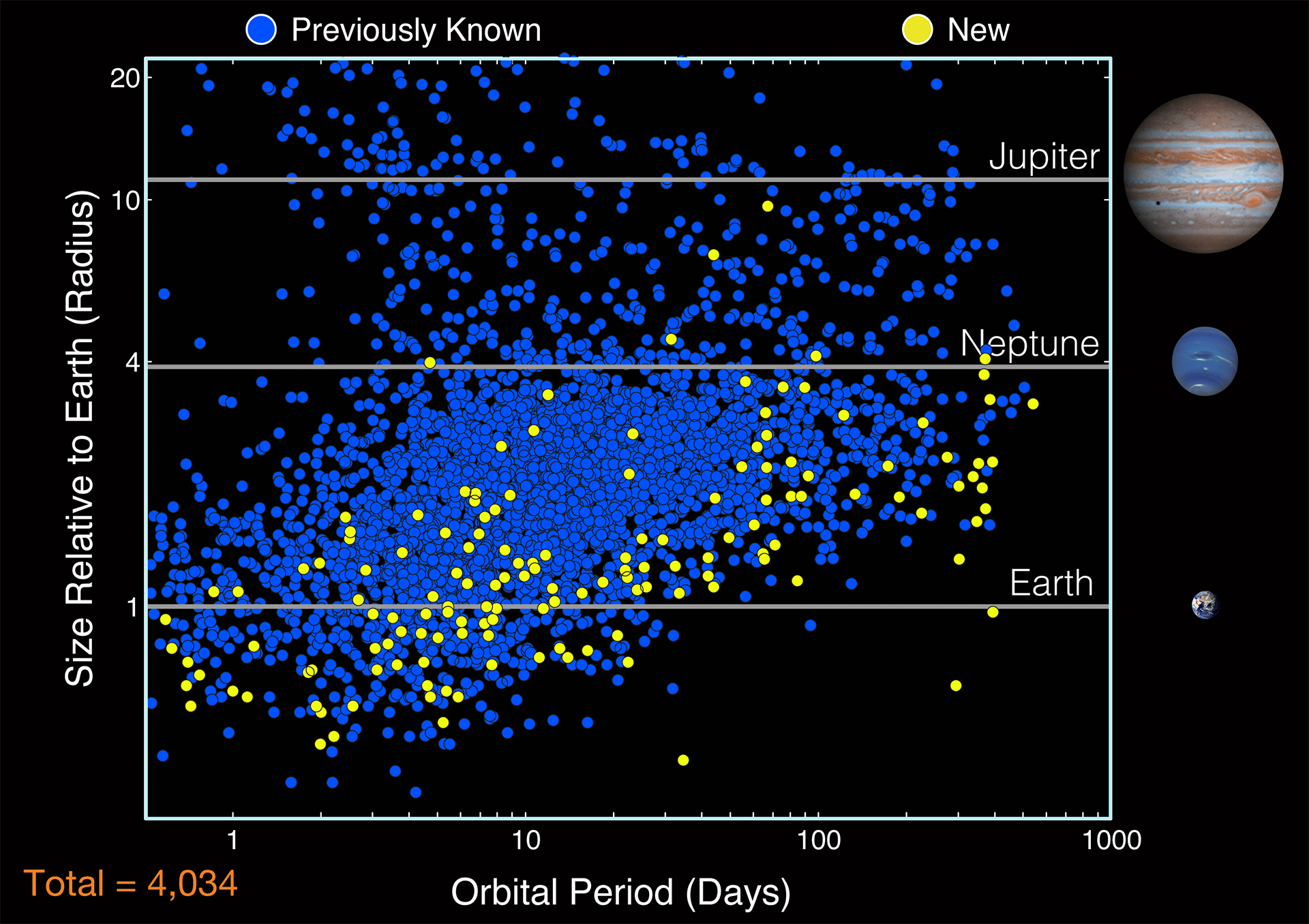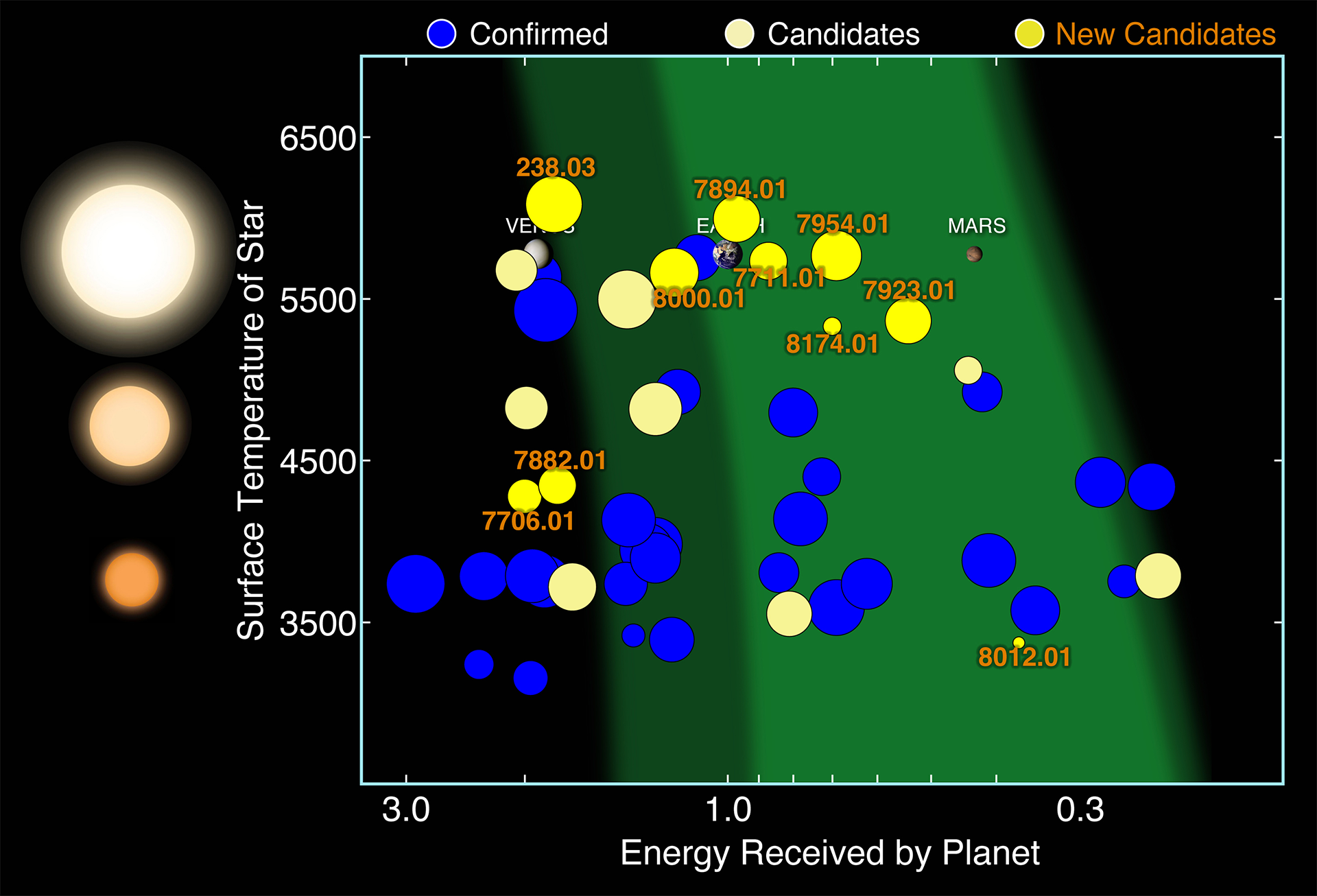Found another 10 Earth-like planets in the habitable zone.

The scientific group of the Kepler space telescope released the eighth and final version of the catalog of candidate planets, in which the list increased by 219 planets and reached 4,034 candidate planets. Ten of them are terrestrial in size and are in the habitable zone. That is, in the range of distances to the star, which allows for the existence of water in the liquid phase on the solid surface of the planet. This completes the processing of data from the first stage of the Kepler mission.
Of the 4034 candidate planets, 2335 are confirmed as exoplanets, and about 50 are detected as earth-like planets in the habitable zone. Of these, more than 30 have already received confirmation.
The eighth catalog contains the most complete data collected in the first four years of the Kepler telescope. This is the latest catalog, which includes information from this part of the sky in the constellation Cygnus. For the final catalog, all the data collected in the first phase of the mission was reprocessed by the most advanced analytical methods, fully automatically. To make sure that no planets are missing from the analysis, a signal from fake planets was added to the system - and they checked how the system detects it.

The telescope observed a limited portion of the starry sky. But the information collected is of the utmost scientific importance. It allows us to estimate the number of earth-like planets in the galaxy — planets on which water may exist, its own life and that are suitable for human life.
In addition, the Kepler data suggest that small planets in space are divided into two distinct types. About half of them are rocky planets that look like Earth. And the second half is gaseous planets smaller than Neptune, hardly capable of supporting life. There are very few planets between these two groups. This is the conclusion reached by one group of scientists who published a scientific paper based on data from Kepler. Using a powerful telescope at the Keck Observatory, they measured with a high accuracy the radius of 2000 Keplerian planets and 1300 stars from his field of view.
Apparently, nature tends to make rocky planets up to 175% of the Earth’s size. Scientists can not yet understand why about half of the planets take in a small amount of hydrogen and helium, which dramatically inflates their size and brings them closer to the size of Neptune.
But still, terrestrial planets in the galaxy are very common.

Ten new candidate planets in the habitable zone from the Keplerian catalog are shown in the illustration. They all have a size of less than 200% of the earth. The conservative habitable zone is depicted with a light green field, the optimistic region is added with a dark green one. Almost all the planets are in the orbit of stars with temperatures close to the Sun (about 5800 K).

These discoveries are important in our future search for extraterrestrial life. The telescope will go down in history - it first showed the planets, such as the Earth, about the same size and in the same orbit. Such data are missing in the results of any other telescope. Kepler is the only one capable of finding planets in a relatively distant orbit from its native star, with sidereal periods of more than 100 days.
The Kepler catalog will be the foundation for further study, how widespread are exoplanets in the galaxy, and what types they break down. “Understanding the frequency of their occurrence in the galaxy will help in designing future NASA missions for a direct survey of another Earth,” said Mario Perez, a Kepler scientist from the NASA Astrophysics Division of the Science Missions Office.

The illustration shows the field of vision of the Kepler telescope. Each rectangle corresponds to a specific region, which is processed by each CCD element of the Kepler photometer. The telescope has 42 CCD elements of 5 × 2.5 cm, resolution of 2200 × 1024 pixels, in pairs. Each pair forms a square, and the total resolution of the matrix is 95 megapixels. Data from the matrix is removed every 6 seconds, reaches the saturation limit and is summed up in the on-board computer for 30 seconds for each pixel. The receiver bandwidth is 430-890 nm. Stars are available for observation up to the 16th magnitude
The astronomical satellite with the Kepler space telescope is the first ever device created to search for exoplanets. The observatory could simultaneously observe more than 100 thousand stars. The launch of the device took place on March 6, 2009, on May 12, 2013, Kepler failed, and on April 11, 2016, control over the telescope was restored.
In the second part of the mission, after the restoration of control, Kepler will continue to monitor other parts of the sky, search for interesting astronomical objects and more detailed study of interesting systems, such as TRAPPIST-1 with seven earth-like planets.
The Kepler telescope is looking for planets using the transit photometry method based on observations of the passage of the planet against the background of a star. This method allows you to determine the size of the planet, and in combination with the Doppler method - the density of the planet. It also provides information on the presence and composition of the atmosphere.
Detailed information on each planet can be found on the NASA Exoplanet Archive website . This data warehouse contains information not only from Kepler, but also from other tools. For example, below are statistics for all exoplanets found to date.

“We like to think that in this study, the planets are classified in the same way that biologists identify new animal species,” said Benjamin Fulton, a doctoral candidate at the University of Hawaii in Manoa and lead author of the Keplerian planets classification work. “Finding two separate groups of exoplanets as a discovery that mammals and lizards constitute two branches of evolution.”

